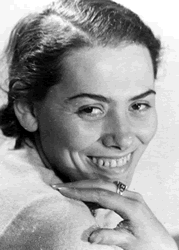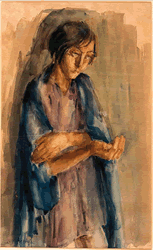Gela Seksztajn, photo courtesy of the Jewish Historical Institute
Gela Seksztajn, painter, born in 1907 in Warsaw, died probably during the Warsaw Ghetto Uprising. Luckily many of her works were saved and are now part of the Ringelblum Archive. Her will includes the following sentence: "I ask not of praises, all I want is to preserve the memory of me and my talented daughter Margelit…"
She was one of approximately 100 creators, who made up the artistic Jewish community of the capitol. She wasn’t very famous, she began to reach artistic maturity and gain critical acclaim as late as in 1938. She specialized in watercolours and drawings. She painted realistic portraits, still lives and landscapes maintained in toned, harmonic colour schemes.
Today she is one of the best-known figures of the closed district. Over 300 of her drawings, gouaches, and watercolours from the years 1930-1942 are part of the Warsaw Ghetto Archive. The collection includes also her biography, her and her husband’s wills and other personal documents. The archive was created at the initiative of Emanuel Ringelblum (1900-1944), who founded the conspirational group "Oneg Szabat" (Satuday’s Joy) which collected and edited various materials. Seksztajn’s husband Izrael Lichtensztejn (1904-1943) apart from being a writer and a teacher was also a member of this underground group. He participated in the hiding of the first part of the archive in 1942. He filled one of the 10 chests that were at his disposal with Gela’s works. By doing so he preserved the memory of the artist and her work.
Youth
Gela Seksztajn came from a working class family, her father was a shoemaker. Her mother, who came from the intelligentsia died in 1918. In 1924 Gela finished the CISZO (Central Yiddish School Organization) primary school in 68 Nowolipki street. The writer Jehoszua Singer was the first to discover her talent. He introduced her to the actor and director – Jonas Turkow, who in turn acquainted her with the known sculptor Henryk Kuna. Thanks to Kuna the Ministry of Denominations and Public Enlightenment granted her a two-month scholarship at the Kraków Academy of Fine Arts. In the beginning of the thirties the artist showed her gratefulness by painting portraits of those who helped her. One of her earliest watercolours shows an image of Singer. In Kraków she spent approximately 13 years and during that time she studied at the academy for 2 years. Her name doesn’t however figure in the registers of students that may be found in the school’s archives. She also worked in a photographic parlour as a retoucher – that’s probably were she grew to appreciate portrait art.
Gela Seksztajn, fragment of the painting "Portrait of a Girl", paper, watercolour, dated 1932-39,
photo courtesy of the Jewish Historical Institute.
She started her artistic career in 1930 in Warsaw. Since 1931 she regularly participated in exhibitions organized by Jewish artists in the capitol. She was a member of two Warsaw societies –of The Society of Jewish Plastic Artists and of The Jewish Society for the Propagation of Fine Arts. It seems however that her closest friends were writers rather than plastic artists. Her will points to this as does the fact that she painted over 20 portraits of people involved with the Union of Jewish Writers and Journalists. These works are now part of the Ringelblum archive. They were painted with watercolours or drawn on tissue paper and they skillfully show such people as Moj?esz Broderson, Szymon Horo?czyk, Icyk Manger, Baruch Gelman, Jehoszui Singer and others.
In 1935 the art historian and art dealer Józef Sandel met her in the Union headquarters in 13 T?omackie street. He wrote down his impression of her:
"To paint was her only wish. […] The development of her artistic skills was constantly hindered by her poor living conditions, but she never lost hope that she’ll realize her goals. She very much liked to draw children. She loved them and she could find beauty in every infant. She felt alive, relaxed and happy when she painted a Jewish child" ("Jewish Painters in the Warsaw Ghetto" in "Nasze S?owo" 1948, no. 6-7).
Family Life
Gela came back to Warsaw in 1937 with the intention to settle down in the city. Her decision was probably influenced by her acquaintance with Izrael Lichtensztejn. They married in 1938 and started to live in 29/23 Okopowa street. After the wedding Gela’s living conditions changed for the better. Thanks to her husband she worked in Jewish schools teaching drawing and plastic arts. Together the couple led summer camps for children in Kazimierz Dolny on the Vistula river. They went there twice, in 1938 and in 1939. Gela portrayed children, she created still lives and landscapes. It was probably the school community that convinced her to organize the individual exhibition entitled"Jewish Child".
The end of the thirties was a very busy time in her life. Most of the watercolours and drawings from the Reingelblum collection were made in this period. In 1938 she participated in two exhibitions and she received warm reviews. In 1939 she took part in the jubilee "Salon of the Society of the Jewish Plastic Artists".
The information about the painter’s life from September 1939 to April 1943 is scarce. Probably both she and her husband lost their jobs as the Jewish schools and cultural institutions were shut down at the turn of 1939 and 1940. Just before the ghetto became a closed area, on the 4th of November 1940 she gave birth to her daughter Margelit. Less than two years later she wrote in her will that "my daughter is my pride and joy. A healthy, talented and pretty child. She is also a source of pain and drama. If I would want to live it would be foremost for my beloved daughter".
Ghetto
The Lichtensztejns were forced to move a number of times. According to historical documents they stayed in their prewar home in 29/23 Okopowa street until October 1940. Since April 1942 they lived in 81 Pawia street and later in 93 Dzielna street.
In the ghetto they tried to continue their normal occupations. Izrael joined the abovementioned "Oneg Szabat" group, he worked for charitable organizations and became one of the managers of the kitchen of the primary school no. 145 in 68 Nowolipki street. This educational institution also employed Gela. She taught how to draw and prepared exhibitions of her students’ works. She also created costumes and decorations for school plays, for instance for "The Seasons", a spectacle which was staged at the Femina theatre in 1942. She was praised for her commitment; in 1942 she received an award from the chairman of the Judenrat - Adam Czerniakow.
Even though she had to fight for the survival of her family and tend to her child, which took up most of her time, she still tried to paint. She concentrated on people from her closest surroundings – on her family, pupils, work colleagues and friends. Her artistic stance was expressed by the words of her last will: "I can’t convey the details of our horrible fate, of our great national tragedy. I leave that to my friends, the Jewish writers".
The only known self portrait of the painter comes from this period. She most probably maintained contact with the literary and artistic communities, which concentrated about the ghetto kitchens. The writers at first dined in 5 Karmelicka street, later in 13 T?omackie street, the journalists went to 14 Leszno street and the artists to 6 Orla street.
On the 22nd of July the Nazis began to deport the inhabitants of the ghetto to the extermination camp in Treblinka. The operation carried on, with intermissions, until the 21st of September. Approximately 300 000 thousand people were transported and killed. At the turn of July and August, in unusually dramatic circumstances, Gela was preparing to hide her paintings. She wrote: "now I’m saving what I can. I leave the rest to God’s care. I ask anyone who finds my works to take into consideration that I had to reduce their formats to adjust them to the existing conditions". At this point she probably signed most of the pieces with Jewish inscriptions and provided them with identification numbers.
From the account of Bela (Wanda) Elster it is known that Gela with her family and friends managed to survive the great selection, which took place in the ghetto from the 6th to the 12th of September. The artist and the rest of the group stayed in a hideaway that was located in the premises of the school in 68 Nowolipki street.
We took refuge in a narrow corridor. We crouched and with our hearts beating we listened to the sound of water flowing down a drain pipe. Lichtensztejn with his wife and young child was sitting with us. Suddenly we heard footsteps and German voices. We froze motionless.
(…) We were afraid that the Lichtensztejn baby will wake up and start to cry. We counted the minutes clutching the knives and axes in our hands. Suddenly we heard a waltz. We were stupefied. There was a piano in the deserted school and once the Germans spotted it they
started to play on it. They were sure there was nobody there so they left… We sat in this hideaway for a few days. Ringelblum was the first to come and visit us. He brought news from the world and he also told us how the operation in Mi?a unfolded.
Death
After the "operation" was over the Nazi authorities created a "partial ghetto", which closely resembled a labour camp. The area was covered with workshops – sheds, in which most of the remaining Jews were lodged. It is known for certain that Lichtensztejn and Emanuel Ringelblum were assigned to Bernard Hallman’s shed, which was located close to Nowolipki street. Gela and her daughter kept hiding.
The last "sign" of her life is a letter from the 22nd of Spetember 1942. It was addressed to Mr. Hirszel, a man who had an important position at B. Hallman’s shed. In the note Gela asked to be assigned to the workshop:
"I am possibly the only painter left from all the Jewish painters and generally from all the Jewish creators –there are no artists left. I think that the Jewish nation of the future shouldn’t be composed only of craftsmen (…). The Jewish artist ought to be saved, so that Jewish life can later be recreated by means of the paintbrush and pen".
Sadly, as stated by her husband’s annotation on the document, Gela’s attempt "came to nothing". Lichtensztejn together with Ringelblum participated in the preparations for the uprising. It was Ringelblum, who passed on the information about Lichtensztejn’s death. Gela’s husband expired on the night of the 17th of April:
"In the grey morning we said our goodbyes. Smolar and Lichtensztejn decided to head towards Hallman’s shed [from Brauer’s shed in Nalewki street]. They probably never made it there, because the area they wanted to cross was densely covered with posts manned by Ukrainians, the gendarmerie and the SS. Most likely they were killed along the way, like thousands of other Warsaw Jews".
Basing on information from documents and from relations one has to assume that Gela and her daughter Margelit died during the uprising, which lasted until the 16th of May 1943.
The report from the opening of the chest containing Gela’s legacy contains an important sentence, which was written by dr. Laura Eichhorn in the presence of Bluma and Hersz Wasser, who were friends of the Lichtensztejn family. "Gela and her husband and child perished without a trace, none of their friends that survived, know how the Lichtensztejns died".
Author: Magdalena Tarnowska, April 2013

